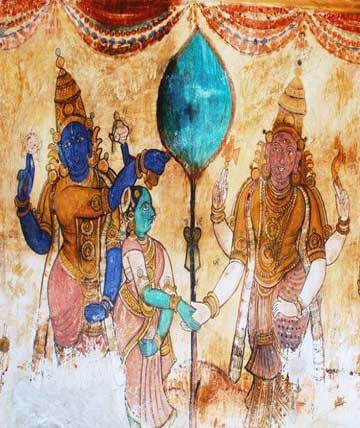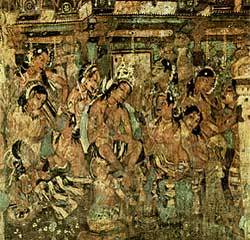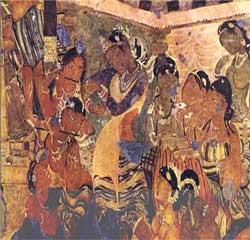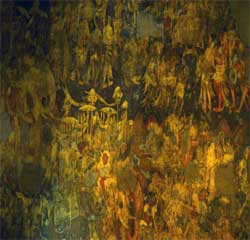Ajantha
The Ajanta Caves carved out of volcanic rock in the Maharashtra Plateau was not far off from the ancient trade routes & attracted traders & pilgrims through whom the Ajanta art style diffused as far as China & Japan. The Buddhist Monks employed artists who turned the stone walls into picture books of Buddha's life & teachings. These artists have portrayed the costumes, ornaments & styles of the court life of their times.
The artists applied mud plaster in two coats - the first was rough to fill in the pores of the rocks & then a final coat of lime plaster over it. The painting was done in stages. They drew the outline in red ochre, then applied the colours & renewed the contours in brown, deep red or black. The attenuated poses, supple limbs, artistic features, a great variety of hair styles, all kinds of ornaments & jewellery indicate skilled artisans. In a mural in Cave 10, some 50 elephants are painted in different poses bringing out the skill of the artist in handling these bulky forms in all perspective views, with erected tails & raised trunks, depicting sensed danger. The style of the later murals reveals a merging of two streams of art, Satavahana of Andhra & Gupta art of North India. This resulted in the classical style which had a far reaching influence on all the paintings of the country for centuries to come.
A high degree of craftsmanship incorporating all the rules laid down by ancient Indian treatises on painting & aesthetics are evident. One cannot but notice the fluid, yet firm lines, long sweeping brush strokes, outlining graceful contours, subtle gradation of the same colour, highlighting nose, eyelids, lips & chin making the figures emerge from the flat wall surface. Animals, birds, trees, flowers, architecture are pictured with an eye to their beauty of form. Human emotions & character are depicted with great understanding & skill - indignation, greed, love & compassion.

Elephant Ajantha painting

Balaji God Ajantha paintings



